Paella de Adobo by Senor Anastacio de Alba
As an Amazon Associate and member of other affiliate programs, I earn from qualifying purchases.
A paella dish always defined our Easter Sunday family meals. For six weeks, every Friday of Lent, my parents steadfast in their faith, taught us to go meatless. I admit it was tough for me, when I was a kid. The hardest day of all was on Good Friday. It seemed like the longest day ever to go meatless and fast to only one full meal that day.
This is why we could hardly wait for Easter Sunday when my mom rolled out all the special dishes she prepared for our big family lunch. There was no holding back for us. Everything was elaborate, there were heaping portions for us to help ourselves and it was just one big feast of meat, seafood, vegetables and all things delightful.
I can never forget how my mom fussed over getting all her ingredients together for paella. For weeks, she checked her ingredients and planned the Easter menu with precision for a perfect meal. And like her paella, I wanted mine to be just as good for the family this Easter. Just in time for this occasion, I received a new cookbook all the way from food friends in Manila. My friend, Ige Ramos, award-winning editor and author sent me “The Alba Cookbook of Senor Anastacio de Alba & Miguel de Alba” (edited by Nancy Reyes-Lumen, also known as ‘the Adobo Queen’ in Manila). This Filipino cookbook contains an interesting collection of Spanish-inspired recipes of Mr. Alba who owned one of the premier Spanish restaurants in the Philippines. I quickly read through the different recipes that ranged from the classic Spanish dishes, modern entrees, desserts and beverages – all inspired and infused with Spanish ingredients, but made delightful for the Filipino palete.
The book described how much Senor Alba loved the Philippines and Filipino food. In honor of this affection, he developed a number of fusion dishes that were uniquely his – and one of them was the “Paella de Adobo”.
I was intrigued by this dish because it was Spanish in origin, yet it was a Filipino dish. Already, I knew the flavors would be enjoyed with relish by my family. This is the kind of dish you make ahead and when you do, the flavors are a reward in itself.
First, I cooked the chicken adobo separately. Adobo always tastes better the day after or even many days after that. By then, the garlicky-vinegar stew it cooked in has seeped deep into the chicken pieces, giving you a very sharp tartness, slightly salty, a tinge of sweetness and the bonus of a rich dark adobo gravy. It is this base that goes magnificent on the bed of rice mixed with the bounty of the vegetable ingredients. You will enjoy the adobo sauce’s strong flavors, the saltiness paired with the vegetable’s crunch and saffron’s floral fragrance as you blend it all together with the white rice, which will slowly turn a roasted light brown. It will look irresistible. And its potent garlic aroma will be so inviting.
Serve this on Easter Sunday, after six weeks of going meatless on Fridays. It’s just the kind of festive dish to indulge the family with. As for me, going meatless on Good Friday will be just fine, knowing we will have this to look forward to. Some things you just never get over. Ever.
Paella de Adobo
Equipment
- Large skillet or paellera - 14 inches in diameter
Ingredients
- 2 to 3 pounds with bone chicken pieces, cut up
- 6 cloves minced garlic
- 2 pieces bay leaves
- 1 teaspoon whole black pepper corns
- 3 Tablespoons for the adobo vegetable or corn oil
- 1/4 cup vinegar
- 1 teaspoon salt
- 1 to 2 cups for cooking adobo water
- 1/4 cup extra virgin olive oil
- 2 whole pieces 6 oz. total sliced Spanish chorizos
- 1 Tablespoon chopped garlic
- 1 whole large chopped white onion
- 1 cup cut in 1-inch pieces, stems trimmed green beans
- 1 cup sliced carrots
- 1 whole sliced, seeded, white membrane removed red bell pepper
- 3 cups long grain white rice
- 6 cups chicken broth
- 1 packet about half a tablespoon saffron
- 2 pieces peeled, sliced, for garnish hard boiled eggs
- 1 medium chopped, seeded, for garnish tomatoes
- 1/2 cup for garnish green olives
- 3/4 cup if using canned, drain the water out frozen green peas
Instructions
- Cook the chicken adobo ahead of time. Put all the ingredients together in a deep stock pot : chicken pieces, garlic, bay leaves, whole black pepper corns, cooking oil, vinegar, salt, water. Simmer over medium heat for 1 and ½ hours up to 2 hours till chicken is thoroughly cooked and tender. The gravy would have reduced and turned slightly thicker. Set aside.
- To cook the paella : over medium high heat, in a large skillet, place the extra virgin olive oil. Add the sliced chorizos and stir around to flavor the oil, for 2 to 3 minutes. When the chorizos turn slightly glazed, and crisp at the edges, remove from the skillet and set aside.
- Using the same olive oil and skillet and maintaining a medium heat, saute the garlic and onions in extra virgin olive oil. Add the rice and mix around the skillet for about 3 minutes till the grains get puffy. Add the saffron and broth. Bring the rice mixture to a boil after about 8 minutes. Lower the heat to a slow simmer. The rice will cook completely in about 7 minutes. Stir the rice mixture every so often to avoid sticking in the bottom of skillet.
- Before the rice gets cooked, at the last 7 minutes, add the green beans, carrots and red pepper slices to the mixture. Then add the pre-cooked chicken adobo. Add the green peas and sliced Spanish chorizos last. Stir the mixture so rice does not stick at the bottom.
- Season with salt and pepper. Cover skillet and let the flavors blend well for a few minutes more up to 10 minutes. Turn off the heat, but keep the paella covered. Even if the heat is off, the skillet is still hot and the rice and ingredients will continue to cook at a low temperature.
- Garnish with sliced eggs and chopped tomatoes. Serve hot.
- Cook’s Comments: the original recipe indicated the use of pork spareribs, cut in cubes for the adobo. Also, large shrimps or prawns and crabs, cut in half, were added to the paella dish. Feel free to include as you prefer. In addition, instead of the suggested salted red eggs by Senor Alba in this recipe, I used regular hard boiled eggs. My personal preference for Spanish chorizos gave the dish the salty element needed.

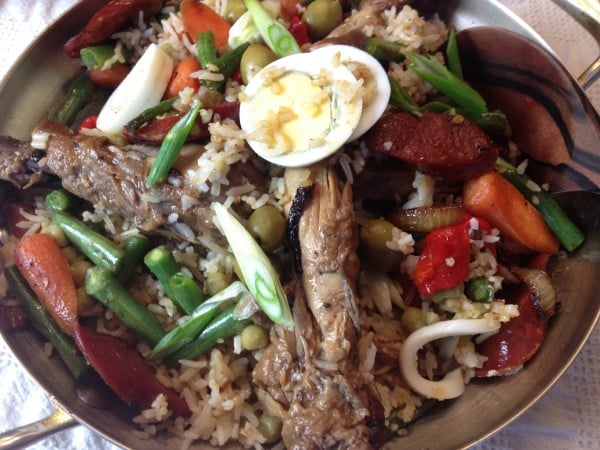
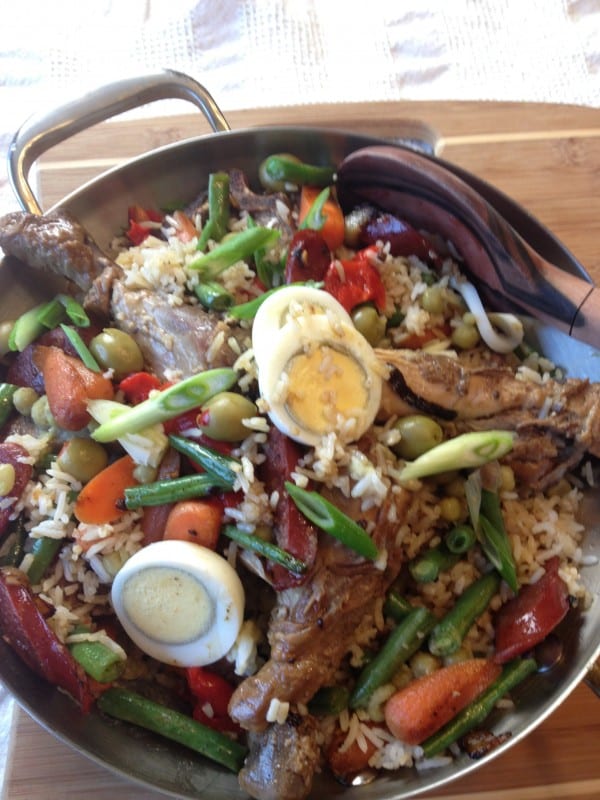
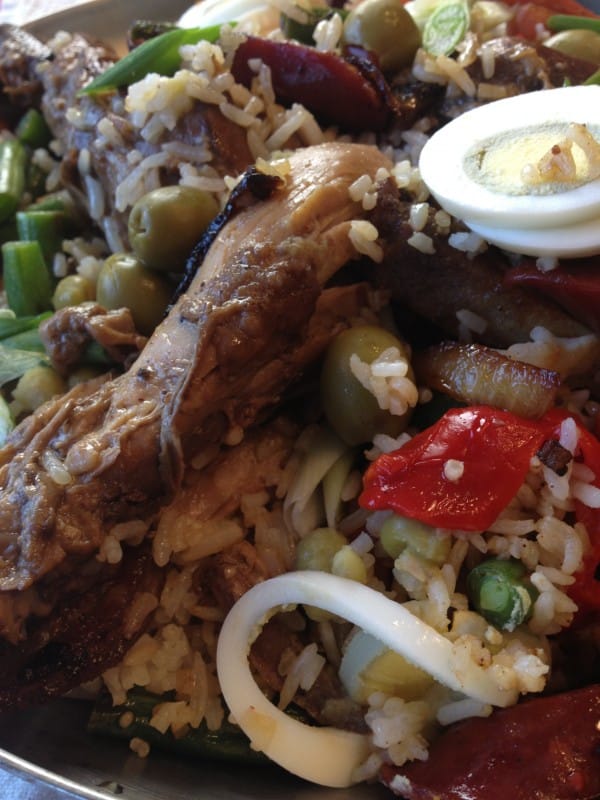
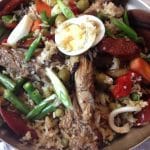
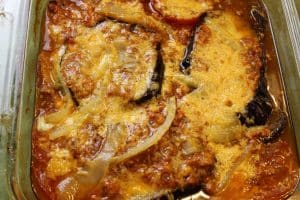
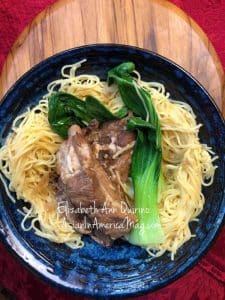
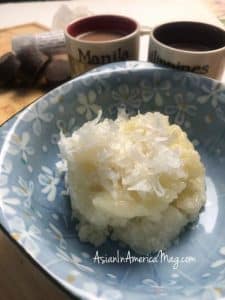
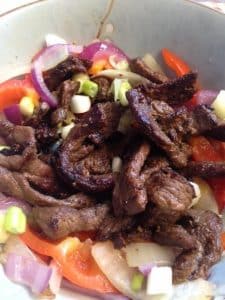
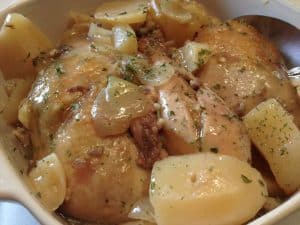
Hello Betty Ann, I am delighted you stopped by my website so that I could find yours. After 6 weeks of meatless Fridays, I am certain your paella would be a welcome delight. I love the addition of chorizio and the saffron. I guess I will have to look through your other recipes to find your mango recipes. Looking forward to keeping in touch. Take Care, BAM
Thanks, Bam! So nice of you to stop by the blog with the kindest words. Yes, this paella de adobo is terrific. I look forward to sharing more food stories with you, as well. Enjoy your Easter holiday!
This looks wonderful and I’m loving all of the ingredients!
Thanks, Mary! So nice of you to say that 🙂
I wish this was our Easter tradition!!!!
Thanks, Laura. It was a nice tradition and I miss my mom’s cooking so I try to re-do for my own family during the holidays.
Thanks for sharing the recipe! Love your site and thank youfor sharing your memories. Would you mind listing your favorite filipino cookbooks?
What kind of green beans did you use? I just picked up my first ever paella pan and i’m So excited to use it. I’m glad I came across your recipe.
Hi Wren, I’m based in the USA, so at supermarkets here they are labeled “green beans”. When I lived in the Philippines, these were called “Baguio beans” – because they were grown in Baguio, I assumed. I hope that helps.